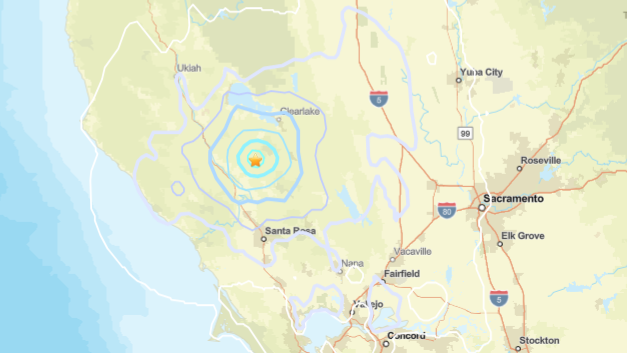California residents were jolted awake early Monday morning as a series of earthquakes struck the northern part of the state in rapid succession, raising concerns among both local communities and scientists about the region’s ongoing seismic activity. The tremors, some of which were felt hundreds of miles away, highlight the persistent vulnerability of California to earthquakes due to its complex network of geological faults.
According to the U.S. Geological Survey (USGS), at least seven distinct tremors were recorded, ranging in magnitude from 1.1 to 4.1. The largest of these occurred at 7:08 a.m. Pacific Time (10:08 a.m. Eastern Time) near The Geysers geothermal field, a well-known site in northern California. The remaining tremors were likely aftershocks triggered by the initial larger quake. Reports indicate that shaking was not confined to the immediate vicinity of the epicenter. Residents in cities as far south as San Francisco described feeling the ground move beneath their feet, with some reporting swaying buildings and rattling objects.
The Geysers: A Hotbed of Geothermal Energy and Seismic Activity
The epicenter of Monday’s earthquakes, The Geysers, is the largest geothermal field in the United States, situated in the Mayacamas Mountains and spanning portions of Sonoma, Lake, and Mendocino counties. The site encompasses roughly 45 square miles and is home to 18 geothermal power plants. These facilities utilize underground steam to generate electricity, a process that has made the region both a hub for renewable energy and a hotspot for minor seismic activity.
Although the name “The Geysers” might suggest erupting geysers similar to those in Yellowstone National Park, the area actually contains steam vents known as fumaroles. The name was mistakenly given by early settlers who misinterpreted the natural phenomenon. These fumaroles release high-pressure steam into the atmosphere and are a visible sign of the geothermal energy lying beneath the surface.
Beneath the geothermal field lies a complex network of geological faults, including the Bartlett Springs Fault Zone and the Healdsburg–Maacama Fault system. Smaller faults crisscross the area as well, and experts say this intricate fault network contributes to the frequent earthquakes observed there. The region’s geothermal energy operations may further influence seismic activity, as the processes used to extract steam and heat can alter subsurface stress levels.
Understanding the Cause of the Tremors
Seismologists explain that earthquakes in The Geysers are triggered by a combination of natural and human-induced factors. The extraction of steam and heat from underground reservoirs causes surrounding rock to contract. This contraction changes the stress distribution within the rock formations, which can set off tremors, sometimes felt on the surface as mild earthquakes. In addition, the practice of reinjecting reclaimed water back into the steam chambers contributes to seismic activity. When cold water is pumped into extremely hot rock, the stark temperature difference can destabilize the underground environment, producing additional quakes.
Despite this activity, the USGS has emphasized that while minor to moderate tremors are relatively common in the area, the likelihood of a truly large earthquake remains low. “It is possible that a magnitude 5 could occur, but larger earthquakes are thought to be unlikely,” the agency stated. “For a larger earthquake to occur, a large, continuous fault must exist. At The Geysers, no such fault is known to exist.” Nevertheless, residents are reminded to remain vigilant, as even relatively small quakes can cause damage under certain conditions.
Impacts Felt Across Northern California
The seismic events on Monday morning affected a wide area of northern California. Reports from Sonoma, Lake, and Mendocino counties describe shaking strong enough to rattle windows and cause minor structural damage in older buildings. In San Francisco, some residents reported a rolling sensation similar to being on a moving vehicle, while others noted that hanging objects, picture frames, and items on shelves were disturbed. Although no major injuries or serious damage were reported, the tremors served as a stark reminder of California’s vulnerability to earthquakes.
Local authorities and emergency services confirmed that they were monitoring the situation and advised residents to take standard earthquake precautions. These include securing heavy objects, knowing safe locations in their homes such as under sturdy furniture, and having emergency kits ready with essential supplies. Businesses in the affected areas also activated safety protocols, ensuring that staff and patrons were out of immediate danger.
California’s Seismic Profile
California is the third-most seismically active state in the United States, behind Alaska and Hawaii. It sits along the boundary of the Pacific and North American tectonic plates, a region known for frequent earthquakes of varying magnitudes. While Alaska experiences the highest number of tremors annually—nearing 60,000 this year—California’s earthquakes are more likely to cause damage due to the state’s dense population and extensive infrastructure.
Data from the USGS indicate that California has already experienced over 14,000 tremors so far this year. While the majority are minor and cause little to no damage, the cumulative effect of repeated shaking can stress buildings, roads, bridges, and utilities. This makes earthquake preparedness an ongoing concern for residents and policymakers alike.
The state has invested heavily in earthquake monitoring and early warning systems in recent years. Advanced sensors and seismic networks provide data in real time, allowing both authorities and the public to respond quickly. Residents can receive alerts on smartphones and through public broadcast channels, sometimes giving seconds of warning before shaking begins—enough time to take cover. These measures have saved lives in previous earthquakes and continue to be refined to account for growing urban populations.
The Role of Geothermal Operations
The Geysers area is unique in that human activity—specifically, geothermal energy production—can influence seismic activity. While the tremors are mostly minor, there is ongoing research into the long-term effects of extracting and reinjecting steam and water into underground reservoirs.
Geothermal power is generally considered a clean, renewable energy source, producing electricity with minimal carbon emissions. However, scientists acknowledge that the process of altering underground pressures can trigger what are known as “induced earthquakes.” These differ from natural tectonic earthquakes in that they are directly linked to human activity. While the induced earthquakes are typically low in magnitude, they raise important questions about the intersection of renewable energy development and public safety.
According to experts, proper management of geothermal reservoirs can minimize risks. Techniques include controlling the rate of water reinjection, monitoring pressure changes, and regularly assessing the stress on nearby faults. By carefully balancing energy production with geological stability, operators can continue to harness steam for electricity while reducing the likelihood of damaging tremors.
Community Response and Preparedness
Following the Monday morning quakes, local communities reported heightened awareness and precautionary measures. Schools conducted safety drills, and residents discussed emergency plans with family members. Social media platforms were flooded with firsthand accounts of the shaking, as residents shared their experiences and checked in with neighbors.
Emergency services emphasized that while the quakes were relatively minor, the region’s residents should remain vigilant. The unpredictable nature of earthquakes, particularly in a geologically complex area like northern California, means that even moderate events can have unexpected consequences. By maintaining preparedness, communities can reduce risks and ensure rapid response in the event of a more significant seismic event.
Historical Context
California’s history is dotted with significant earthquakes, ranging from the catastrophic 1906 San Francisco earthquake to more recent tremors in the 1980s and 1990s. While the majority of earthquakes are minor, the state’s dense urban centers mean that even moderate quakes can disrupt daily life and cause economic losses. The Geysers area, while less densely populated than major cities, has nonetheless experienced frequent minor quakes for decades, linked both to natural fault movements and geothermal activity.
Over the years, lessons learned from these events have shaped building codes, infrastructure development, and emergency response systems. Modern structures are now designed to withstand significant shaking, and public education campaigns emphasize the importance of preparedness at home, work, and school.
Looking Forward
Seismologists continue to monitor The Geysers and other seismically active regions of California closely. While the recent tremors are not expected to result in a major earthquake, ongoing research seeks to better understand the mechanisms that trigger quakes in areas influenced by geothermal operations.
Experts recommend that residents of California maintain earthquake kits with water, non-perishable food, first aid supplies, flashlights, and essential medications. They also advise practicing “Drop, Cover, and Hold On” drills regularly, identifying safe spots in homes and workplaces, and staying informed through official channels for real-time updates on seismic activity.
In summary, Monday’s earthquakes at The Geysers serve as a vivid reminder that California’s seismic activity is both a natural and human-influenced phenomenon. While the recent quakes were relatively minor, they underscore the need for preparedness, careful monitoring, and ongoing research to ensure that communities remain resilient in the face of California’s ever-present earthquake risk.

Emily Johnson is a critically acclaimed essayist and novelist known for her thought-provoking works centered on feminism, women’s rights, and modern relationships. Born and raised in Portland, Oregon, Emily grew up with a deep love of books, often spending her afternoons at her local library. She went on to study literature and gender studies at UCLA, where she became deeply involved in activism and began publishing essays in campus journals. Her debut essay collection, Voices Unbound, struck a chord with readers nationwide for its fearless exploration of gender dynamics, identity, and the challenges faced by women in contemporary society. Emily later transitioned into fiction, writing novels that balance compelling storytelling with social commentary. Her protagonists are often strong, multidimensional women navigating love, ambition, and the struggles of everyday life, making her a favorite among readers who crave authentic, relatable narratives. Critics praise her ability to merge personal intimacy with universal themes. Off the page, Emily is an advocate for women in publishing, leading workshops that encourage young female writers to embrace their voices. She lives in Seattle with her partner and two rescue cats, where she continues to write, teach, and inspire a new generation of storytellers.









